Table of Contents
ToggleSapthagiri magazine article - Sri Venkatesa Sahasranama - Commentary in English by Sri Ananth Madabhooshi
Venkatadri samam sthanam Brahmande Nasti kinchana |
Venkatesa samo devo na bhootho na bhavishyati ||
The above widely known sloka appears in the Brahmanda Purana which negates beyond any doubt the existence of any place equivalent to Tirumala in the whole universe and similarly negates the existence of any god equivalent to Lord Venkatesa anytime in the past as well as in the future.
Apart from the Brahmanda Purana, eleven other Puranas among the famous set of eighteen Puranas speak highly of Venkatachala. The antiquity of the holy range of hills, Venkatachala also known as Tirumala, is such that even the foremost authority of ‘Sanathana Dharma’, the Rig Veda renders a verse in praise of Tirumala and prods people to visit the shrine and be blessed.
Divya Prabandham
Alwars who took their birth in Kaliyuga sang in praise of Venkatachala and Lord Venkatesa. The works of Alwars called Divya Prabandham, a collection of nearly four thousand hymns in Tamil profusely interspersed with different emotions of Alwars, have accorded a place to the Hills at par with Lord Venkatesa.
The supremacy of the Hills and that of Sri Venkatesa as Srimannarayana Himself was established beyond any room for doubt, by Sri Ramanuja nearly a thousand years ago.
The Uniqueness of Sri Venkatesa Sahasranama
For the liberation of mankind, people are bestowed with a lot of means to engage themselves in the blissful devotion towards God and the best among the means in this Yuga is said to be ‘Namasankeerthanam’, which is chanting or singing or reciting or just listening to different names of God.
This is facilitated by Sahasranama, a collection of thousand names.
There are many Sahasranamas in Bhakti literature and in general the very name signifies Sri Vishnu Sahasranama.
Besides, there are many like
- Lalitha Sahasranama,
- Rama Sahasranama,
- Lakshmi Sahasranama,
- Lakshmi Narasimha Sahasranama and
- Sri Venkatesa Sahasranama.
It is widely known that Srimannarayana manifests Himself in five different celestial abodes namely Para [in Sri Vaikunta], Vyuha [in Ksheerabdhi], Vibhava [descend to the earth as ‘avatara’ like Rama and Krishna] Antaryami pervades inside everything in the universe and Archa is a tangible and visible ‘vigraha moorthi’ in the temples.
Among the many Sahasranamas that exist, Sri Venkatesa Sahasranama is unique as it is attributed to the ‘Archa vigraha moorthi’ of Lord Venkatesa in Tirumala, whereas other Sahasranamas are in praise of ‘Vibhava Moorthis’ called ‘avatars.
Sri Venkatesa Sahasranama was originally sung by Lord Bramha and His ‘Manasaputra’ Narada happened to listen. He persuades Lord Bramha to educate him on this sthotra. Lord Bramha readily does the ‘upadesa’ and Narada in turn passes the sthotra as ‘upadesa’ to ‘rishi’ Vasishta, another ‘Manasaputra’ of Lord Brahma. This is cited elaborately in the Brahmanda Purana.
We attempt to give concise and traditional meanings with relevant explanations for each of the names of Lord Venkatesa in the Sthotra. A thousand names are spread across 159 slokas with a prologue containing thirteen slokas setting the context and necessary rituals for the recital and an epilogue containing another thirteen slokas detailing the fruits of reciting the Sri Venkatesa Sahasranama.
Sri Venkatesa Sahasranama begins with a ‘Purva Peetika’ section containing ten slokas. Rishi Vasishta gets curious about the rituals employed by ‘rishi’ Narada in his prayers and seeks to know what kind of names are being recited.
Narada elaborates on the categories of the names of Lord Venkatesa like those derived or based on His attributes, His glorious deeds, and those that allude to His resplendent nature, and also emphasizes the names are infinite. Further Narada expounds about the efficacy of reciting these names in clearing one’s sins without a trace.
The next section, ‘Dhyanam’ consisting of three slokas, is about setting our minds upon the core subject of the sthotra which is Lord Venkatesa. It also depicts a clear description of His supernal appearance with divine weapons or ornaments like Panchajanya and Sudarsana Chakra and their positions in His celestial hands.
The stotra begins with the first sloka enumerating eight names of Lord Venkatesa.
Sloka - 1
Venkateso virupaaksho
vishweso viswabhavana: |
Viswasrut viswasamhartha
viswapraano viraatvapu: ||
Sloka - 1: Meaning
1.Venkatesa: The name indicates the Lordship or the Ownership of Sriman Narayana over the Venkatachala hill ranges. Sriman Narayana is Venkatesa. The two root words that join together result in the word “Venkata”: “Vem” indicates a comprehensive set of sins and “Kata” means the act of burning down to ashes.
Together they represent the holy shrine that is capable of burning down all the committed, being committed, and yet-to-be-committed sins of the visiting devotees. Venkata+Isa is Venkatesa, wherein Isa indicates the ownership [Thiru Venkatamudayaan].
Alwars also concur with this when they extol the hill as a holy place that eradicates our sins if we merely display an Anjali Mudra towards it. The author of the famous Sri Venkatesa Suprabhata, Prativadibhayankara Anna of the 15th century also repeatedly mentions Venkatesa in many slokas.
It is said that people are born with three debts:
- Debt towards Rishis which can be paid back by learning and reciting Vedas;
- Debt towards Devas which can be paid back by conducting rituals of yagnas and;
- Debt towards Pitrus which can be paid back by begetting good children to continue the family legacy.
All these 3 debts disappear through the act of focused chanting of “Om Venkatesaya Namaha”.
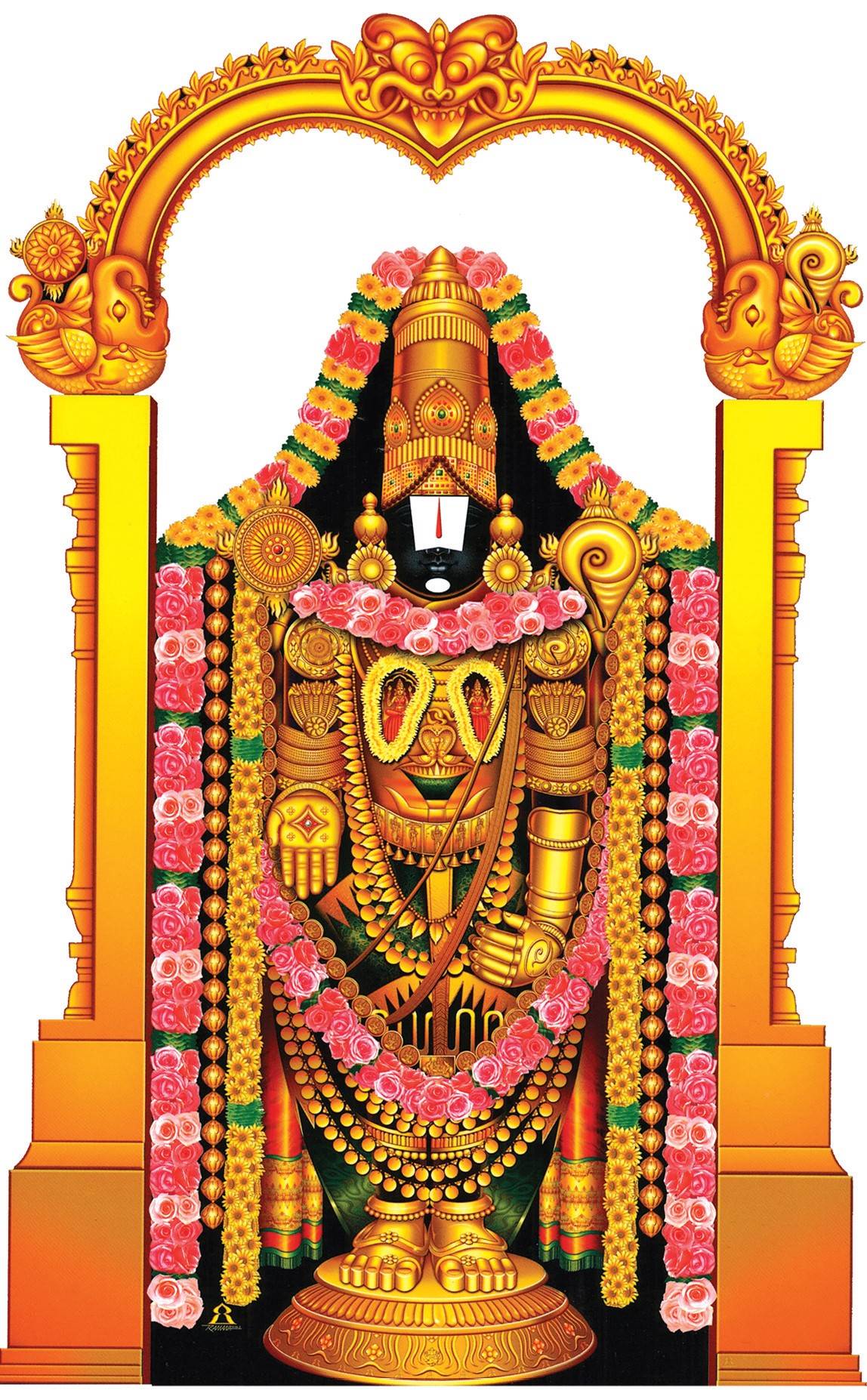
2. Virupaaksha: The ever-benevolent Venkatesa is known to shine with merciful eyes which can exhibit different attributes as per the receiver. In Tiruvaymozhi [3.6.6], Alwar mentions Prahlada as “Seetratthodu arul pettravan” wherein Lord Narasimha was displaying two mutually exclusive feelings simultaneously; He was being mercifully protective about Prahlada while ferociously punitive towards Hiranyakasipu.
Vedanta Desika praises the co-existence of the two different attributes simultaneously in Narasimhavataara in Kaamasikaashtaka stotra [#7].
This can be attributed to Venkatesa also. Besides, the capabilities of different sense organs for normal humans are limited; like eyes can only see, ears can only hear, while God can not only see but also can hear and sense through his eyes [this is attributed as Aghatitha Ghatanaa Saamarthya, which is making the improbable probable, and impossible, possible and thereby plausible too]. Parasara Bhatta states this in Uttara Sataka [#29] of Srirangarajastava.
3. Viswesa: The Isa of Viswam. The owner of the entire universe. In Bhagavad Gita [4.6] Lord Krishna declares “Bhootaanaam eeswaro api san” – I am the owner of all the beings. Nammalvar in Tiruvaymozhi [3.3.3] says “Ennil Tholpugazh Vaanavar Eesane” – The Lord of all Gods and demigods with countless glorious attributes. In the very next hymn [3.3.4], Nammalvar says that Lord Venkatesa showered His grace on an undeserving one like himself. Sri Vishnu Sahasranama starts with the name “Viswam” which indicates fullness in all aspects.
4. Viswabhavana: The support of the universe(s). One who holds the entire existence: The sole refuge and protector of everything. The Jitante stotra starts as “Jitante Pundareekaksha Namasthe Viswabhavana”. Here the commentator Periyavachhanpillai expounds the word Viswabhavana as the primary and exclusive source and reason for creation.
5. Viswasrut: The creator of the Universe without any expectation in return. In Vishnu Sahasranama commentary [#240], Parasara Bhatta says the Lord creates the Universe unmindful of its merits or defects. Alwars extensively sung about the exclusive role of the Lord in the creation of the Universe. Thirumazhisai Alwar in his Thirucchandaviruttam [#12] says “Ulagu thannai nee padaitthi”.
The commentator says, Lord utilized non-sentient MulaPrakriti to create the primordial egg, called Anda, which is called Samasti Srushti and further created Bramha and other demi-Gods through whom He created everything else.
6. Viswasamhartha: The destroyer of the Universe, at the appropriate time. In the same hymn cited in the previous name [#12 of Thirucchandaviruttam], Alwar says “…Ullodukki Vaitthee…” The commentator Periyavachchanpillai says that the Lord protects all the Aathmas, during Nithya, Naimitthika, and Prakruta Pralayas, by preserving them in his abdomen. Nammalvar, in Tiruvaymozhi, addresses Lord Venkatesa as “Ulagam unda peruvaaya…” [6.10.1].
Commentator Nampillai says Lord Venkatesa’s intention and sense of urgency in saving the Universe is found to be bigger than the Universe itself. So, this name is not to be construed in the sense of destruction as it may appear to be. One needs to acknowledge the deep sense of protection Lord Venkatesa exhibits, especially when it is time for the ultimate clean-up.
7. Viswapraana: He is the Life of the Universe. He is the life-sustaining energy. Just like an Aatma accepts a Sareera and stays with it protecting it for a lifetime, Lord Venkatesa is the Aatma for all the sentient and non-sentient beings of the Universe. Nammalvar expresses the same thought in Tiruvaymozhi [6.9.7] when he quotes “…Ulagukke Oruyirumaanay…”.
8. Viraatvapu: The one whose divine form [body] is the whole creation. Purushasukta says “… tasmaadviraad ajaayatha …”. Thus, His effulgence is widely celebrated.
Swamy varu Procession - Golden Chariot - Tirumala
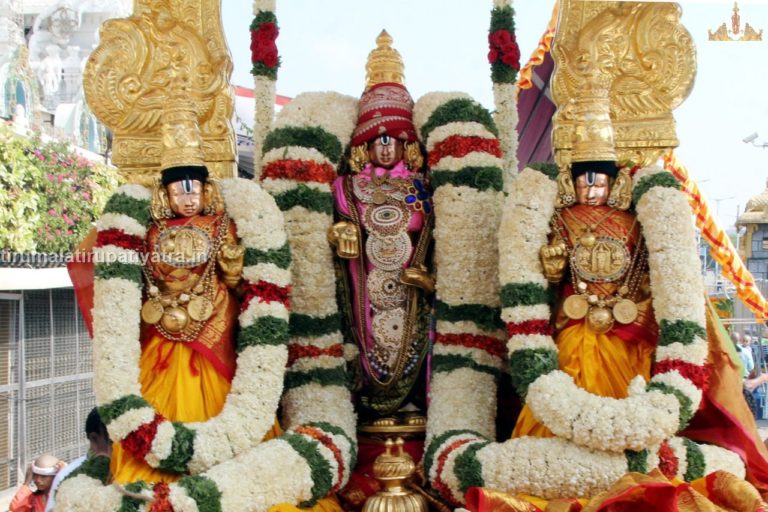
Sloka - 2
Seshadrinilayo AseshaBhaktaDukha Pranaasana: |
Seshastutya: SeshaSayee Viseshagnyo Vibhu Swabhoo: ||
Sloka - 2: Meaning
9. Seshadrinilaya: The one who has made the Seshadri as His permanent residence. In the second chapter of Brahmanda Purana, the Lord instructs Adisesha to transform himself into a hill in the Bhooloka at a place convenient for the Lord to stay and Adisesha descended to become the hill known as Seshadri. Hence this name.
10. AseshaBhaktaDukhaPranaasana: The Lord who destroys the unforgivable infinite sins of His devotees without any trace. Here the word Asesha is an adjective that means infinite and it can be appropriated to Devotees too. Nammalvar too says in Tiruvaymozhi [#3.3.9] ‘Oyum mooppu pirappu irappu pini veeyyumaaru seivaan thiruvenkadatthayan’.
11. Seshastutya: The Lord was extolled by the thousand-hooded primary servant, Adisesha. The word Seshi refers to Lord Srimannarayana and everything else in His creation is Sesha. From Bramha, to Indra, everyone in all directions praises the Lord, as stated in Purushasukta.
12. Seshasayee: The Lord who is assuming a reclining posture on Adisesha. Poigai Alwar lists 7 of the many acts of servitude in Mudhal tiruvandadi (#53). Yamunacharya also lists these acts in his Stotraratna.
13. Viseshagnya: The word “Jnya” indicates someone well aware. Here there’s an adjective, “Visesha” which means special. This name indicates that Lord Venkatesa is a know-all, especially of the differences between any 2 things. That makes one conclude that He is the one who is well aware of everything about everything.
14. Vibhu: The quality of Vibhuthvam indicates the spread of the Lord everywhere and everything. This is about the ubiquitous nature of Lord Venkatesa. Sri Prathivaadi Bhayankaram Annan, who did Venkatesa Suprabhatam says “Sarvaantaraatmane Srimad Venkatesaya Mangalam” in Venkatesa Mangala stotram.
15. Swabhu: “Ajaayamaano bahudha vijaayate” says the Vedas. It means the one who is not subject to the cycle of births, sprung into many forms out of His penchant. This name indicates He is the source of His creation. The commentator for Sri Vishnu Sahasranama also conveys a similar meaning to the name “Swayambhoo” (#37).
Tirumala Temple Front view on New Year Day
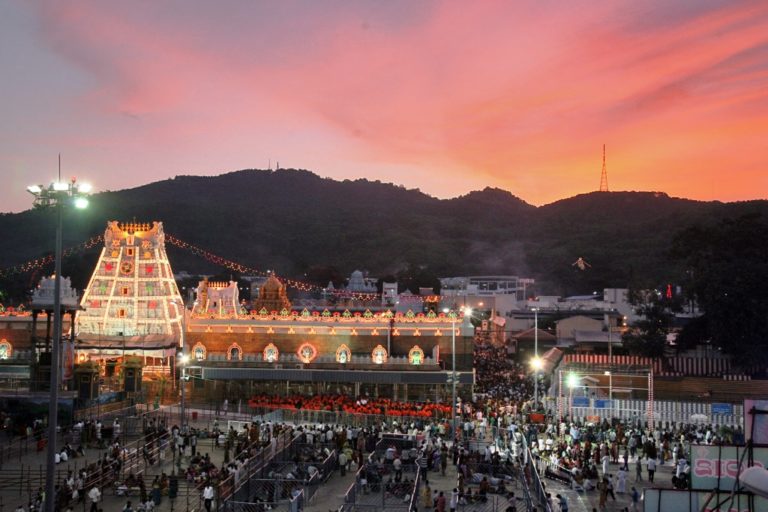
Sloka - 3
Vishnur Jishnuccha Vardhishnu: Utsahishnu: Sahishnuka: |
Bhrahjishnuccha Grasishnuccha Varthishnuccha Bharishnuka:||
Sloka - 3: Meaning
16. Vishnu: This name indicates the omnipresence of Lord Venkatesa. He is all pervasive and the root word “Vis” indicates entry or pervasion. Vadikesari Jeeyar says the name Vishnu indicates the capability to do whatever He wishes to, while being spread all over.
17. Jishnu: He is ever-victorious. In all His avatars, He always emerges victorious against the enemies. As a single-handed Hero, Sri Rama vanquished 14000 Rakshasas in less than half an hour. He always wins to establish righteousness. Being victorious comes naturally and effortlessly.
18. Vardhishnu: One who is capable of expanding or enlarging Himself as He wishes. A dwarfish Vamana transforming Himself into an immeasurable Trivikrama is indicated by this name.
19. Utsahishnu: One who is excited and motivated to protect His devotees and also to establish Dharma.
20. Sahishnuka: One who tends to overlook the lapses and shortcomings of His devotees and is always inclined to protect them. His forbearance towards the lapses is further enhanced by the presence of His Consort, Sri Mahalakshmi. In Venkatesa Suprabhatam, it is said “… tat kshaanti samvardhineem …”, which indicates the act of intensifying His mercy.
21. Bhrajishnu: One who manifests Himself as an effulgent vigraha for the benefit of those devotees who meditate on Him.
22. Grasishnu: One who grasps everything into His fold during the cosmic chaos, Pralaya. Also, the One who also swallows the sins of His devotees to protect them. Lord Venkatesa did not get agitated by an untimely visit of Thondaman Chakravarthy to seek His help in clearing him of an unpardonable sin as stated in Sri Venkatachala Mahatmyam.
23. Varthishnu: One who attempts to be visible to the ordinary eyes of devotees to protect them.
24. Bharishnuka: One who has earnest affirmation to always protect one and all.
Dhwajasthambam Inside Tirumala Temple
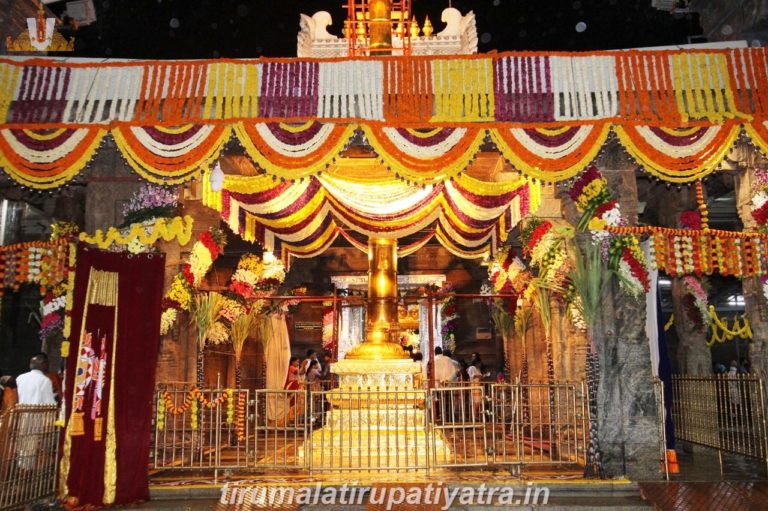
Sloka - 4
Kaalayanta Kaalagopta Kaala: Kaalaantako Akhila: |
Kaalagamya: Kaalakanthavandhya: Kaalakalesvara: ||
Sloka - 4: Meaning
25. Kaalayanta: One who commands the concept of Time. All the variants of the time like dawn, day, night, etc., are under His control. Saint Thyagaraja says “Graha gatulu emi seyunu Ramanugrahamunte..”
26. Kaalagopta: One who protects the devotees who are subject to upheavals of life due to time.
27. Kaala: The one who draws every moving and non-moving thing towards Himself. Nammalvar says He is the one who commands past, present, and future [Tiruvaymozhi 8.1.7]
28. Kaalaantaka: The one who destroys without a trace, the time where the sins are committed.
29. Akhila: This name indicates that He is not subject to destruction. Nammalvar says “Malar chodhi mazhungaade.”
30. Kaalagamya: “Bahoonam janmanante jnyaanavan maam prapadyate” says Krishna in Bhagavad Gita [#7.19]. Lord Venkatesa is the definite final destination for those who lead a devout life [lives] with great discipline in thought, speech, and action which eventually lead them on the path of rectitude.
31. Kaalakanthavandhya: Kaalakantha indicates the one with a black throat [due to the act of swallowing Haalahala to protect the creation], Rudra. Lord Venkatesa receives Rudra’s obeisances. Rudra is the Kshetrapaala of Venkatachalam.
32. Kaalakalesvara: The Lord who has direct control and command over the Time. The denominations of time range from the smallest division within a second to the greater denominations of chatur yuga and this whole spectrum of time’s various divisions is fully controlled by Lord Venkatesa.
Sloka - 5
Sambhu Swayambhu: Ambhojanaabhi: Sthambhitavaaridhi: |
Ambodhi Nandhinee Jaana Sonaambhojapadaprabha: ||
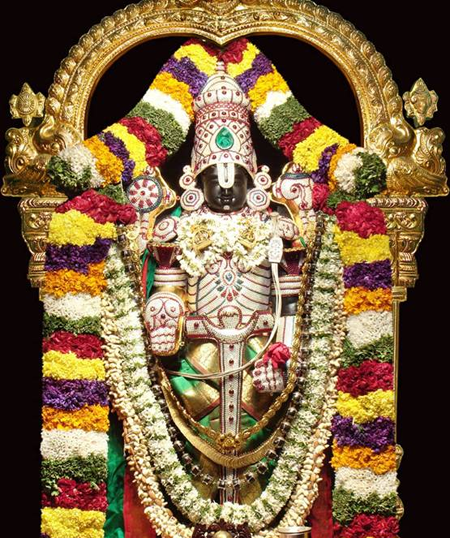
Sloka - 5: Meaning
33. Sambhu: The origin of bliss. “Sam” means happiness and “bhu” indicates the giver. Taittreeya Upanishad says “Viswaaksham Viswa Sambhuvam” which indicates He visualizes all things directly and also He is the reason for the delightful joy for one and all.
34. Swayambhu: He is capable of self-manifesting Himself without any support. He is the One who exists forever. Equivalent to the 15th name.
35. Ambhojanaabhi: The One who held a beautiful Lotus from His navel, which is the source of all creation. Godadevi says, “Koppoozhil ezhukamala poovazhagar” [Nachiyar Tirumozhi T 11.2]
36. Sthambhitavaaridhi: The One who, as Rama, stupefied the Ocean when He found there was no reciprocity of respect accorded to Him by the king of Oceans. Tondaradippodi Alwar says “Oru villal ongu muneer adaitthu” [Tirumalai # 11]
37. AmbodhiNandhineeJaana: The One who is the husband of Sri Mahalakshmi who is considered the daughter of the King of Oceans due to her emergence from the milky ocean during the event of celestial churning. Periyalwar says “Tiruvudayaal Manavala!” [P.T 2.7.2]
38. Sonaambhojapadaprabha: The One whose feet resemble the shine of an idyllic red fresh lotus. Tiruppanalwar begins his prabandham as “Amalanaadhipiraan… Tirukkamala paadam vandu en kanninullana okkinradhey”. Bhakti literature is replete with references that draw parallels between the Lord’s holy feet and the fresh Lotus.
Sloka - 6
Kambugreeva: Sambaraariroopa: Sambharajekshana: |
Bimbaadharo Bimbaroopi Prathibimbakriyaatika:||
Sloka - 6: Meaning
39. Kambugreeva: Venkatesa, whose neck is as beautiful as a pure white Conch in shape and appearance. It is also the same neck that swallowed the entire universe as per Tiruppanalwar who says “muttrum unda kantam kandeer” in Amalanadhipiran [#6]. This very shape can be attributed to the sweetest speech. Rama is referred to as “Kambugreevo Mahaahanu:”
40. Sambaraariroopa: The Lord whose captivating beauty is comparable to that of Manmadha. Pradhyumna is the son of Krishna and Rukmini who is born with an amsa of Manmadha He kills a demon named Sambari and thus the name. It is stated in Sri Venkatesa Mangalam: “…Atruptyamrutha roopaaya Venkatesaaya Mangalam”
41. Sambharajekshana: Venkatesa, whose eyes are like the petals of a refreshingly new Lotus. Nammalvar says “Seyya thaamarai kannanaay…” in Tiruvaymozhi [#3.6.1].
42. Bimbaadhara: The One whose lips are similar in color to the enigmatic red ripened ivy gourd fruit. This fruit displays a unique reddish hue which is very captivating. Tiruppanalwar sounds helpless by getting attracted to the beauty of Lord’s mouth, “seiyya vaay ayyo ennai sinthai kavarnthathuve” in Amalanadhipiran [#7]. In another sloka it is mentioned as “…bimbaadharam bahuladeergha krupakataaksham…”
43. Bimbaroopi: Venkatesa is the primordial reflection of the entire creation or existence. A form like this is to facilitate the devotees to visualize and experience the bliss.
44. Prathibimbakriyaatika: Venkatesa has infinitely divine beauty and tangible features and these features cannot be attempted by anyone to be replicated. A matchless form indicates the superiority of Venkatesa over one and all in the entire creation. Venkatesa is one of the eight Swayamvyakta forms.
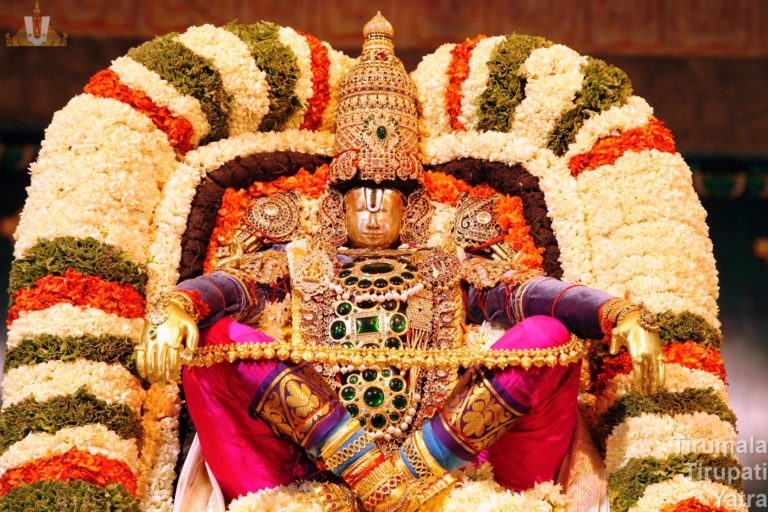
Sloka - 7
Gunavaan Gunagamyaccha Gunaatheetho Gunapriya:|
Durgunadhwamsakrut Sarvasuguno Gunabhasaka:||
Sloka - 7: Meaning
45. Gunavaan: Venkatesa is the treasure chest of all the infinite auspicious qualities. This name assumes a unique position from Sri Ramayana perspective also. Valmiki inquires at the beginning of Sri Ramayana “Konvasmin saampratham loke Gunavaan….”. This inquiry about the worthy attributes triggered the elaborate epic. Further, Yamunacharya says “vashee vadaanyo Gunavaan… samastha kalyaan gunaamrutodadhi:”
46. Gunagamya: Venkatesa is bound by auspicious qualities. The wonderful anecdote of a potter, Kuravai Nambi’s devotion to Venkatesa superseding that of Emperor Thondaman Chakravarthi corroborates this further. Lakshmana explains to Hanuman that he is a servitor to Rama who is an embodiment of all the auspicious qualities. [Ahamasmi avaro bhrathaa Gunair Dasyam upaagata…]
47. Gunatheetha: He has countless attributes and also He is the Shuddhasatva which indicates being entirely different from the traditional 3 categories of Satva, Rajas, and Tamas. Poigai Alwar says “kunranaya kuttram seyyinum gunam kollum…” in Mudal tiruvandadi [#41] which indicates He overlooks the big faults for the small good deeds.
48. Gunapriya: Venkatesa takes the side of those who stand by Dharma and exhibit good qualities. Rama considering Guha among one of His brothers stands testimony to this name.
49. Durgunadhwamsakrut: One who tends to overlook the lapses and shortcomings of His devotees and is always inclined to protect them. His forbearance towards the lapses is further enhanced by the presence of His Consort, Sri Mahalakshmi. In Venkatesa Suprabhatam, it is said “… tat kshaanti samvardhineem …”, which indicates the act of intensifying His mercy.
50. Sarvasuguno: Venkatesa is the embodiment of all the immaculate and auspicious qualities that remain untouched by even a trace of bad qualities ever at all.
51. Gunabhasaka: The One who brings out the good qualities in all at the right time. Venkatesa as Krishna helped Arjuna shun his unwarranted inaction and made him spring into action to ensure Dharma is established by his nectarine Bhagavad Gita.
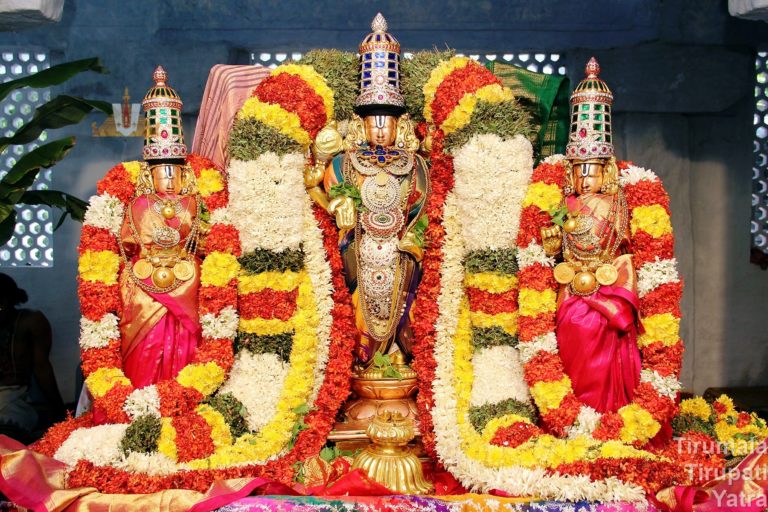
Sloka - 8
Paresa: Paramaatma cha Paranjyothi: Paragathi: |
Parampadam Viyadvaasa: Paaramparya Subhaprada: ||
Sloka - 8: Meaning
52. Paresa: Venkatesa is the One who can grant Moksha. He is the Lord of Lords just as Nammalvar says “… devarkkum deva O …” in Tiruvaymozhi [#8.1.5]
53. Paramaatma: The name indicates the absence of anything beyond Venkatesa. Not even beyond, there is nothing equal to Him either. Nammalvar says “…tannoppaar il appan… “ in Tiruvaymozhi [#6.3.9]
54. Paranjyothi: Venkatesa is the most divine form of radiating effulgence. Also, His radiating beauty is forever, and never does it diminish. “…Em Paranjothi! Govinda!...”says Nammalvar in Tiruvaymozhi [#3.1.3]
55. Paragati: He is the most divine destination and He is also the means or the way to achieve that destination. Annamayya says “Neeve Nidhi Nidhanamu...”
56. Parampadam: The ultimate destination of one and all in the creation. Kulasekara Alwar says “… tunnittu pugalariya vaigundha neel Vaasal …” in Perumal Tirumozhi [#4.3], where he describes how other devas like Rudra, Brahma, and Indra jostle their way into the sanctum sanctorum of Venkatachala, a Paramapada of this world.
57. Viyadvaasa: Venkatesa is the deity having His abode in Sri Vaikunta, also known as Paramaakasa. Varavaramuni says “… kunraatha vaazhvaana vaikundha vaaan bhogam…”. The One who stays ever in Vishnupadha. 58. PaaramparyaSubhaprada: Venkatesa is the bestower of a continuous chain of auspicious boons to the devotees. Goda devi says “… Ettraikkum Ezh Ezh piravikkum …”
Sloka - 9
Bramhaandagarbho Bramhanyo Bramhasrut Bramhabodhitha: |
Bramhastutyo Bramhavaadhi Bramhacharyaparaayana: ||
Sloka - 9: Meaning
59. Bramhaandagarbha: Venkatesa is the origin of the entire creation and thus He is the one who is capable of preserving and guarding the entire creation within Himself. Tirumangai Alwar says “Manjaadu varai ezhum kadalgalezhum… mattrum ellam enjaamal vayittradakki …” in Periya Tirumozhi [#2.10.1]
60. Brahmanya: Venkatesa is the bestower of benefits to those who protect Vedas by reciting them and by knowing the Brahma gnana which is embedded in Vedas and Vedanta. Also the nama #667 of Sri Vishnu Sahasranama.
61. Bramhasrut: Venkatesa is the Creator of Bramha who is in turn the creator of the rest of the creation. Tirumazhisai Alwar says “Naanmuganai Naarayanan padaitthaan…”.
62. Bramhabodhitha: Venkatesa is the meaning of the Vedas and Venkatesa is in turn the One who protected the Vedas. He is the one who bestows the knowledge of Vedas.
63. Bramhastutya: Venkatesa is eulogized by the Vedas. Besides, Bramha also sang the praise of Venkatesa. In Sri Ramayana, Bramha appears after the battle and reminds Sri Rama of His self.
64. Bramhavaadhi: The One who grants the knowledge of the Parabramha. Venkatesa’s avataras as Hayagriva, Kapila, Hamsa and so on stand testimony to this attribute.
65. Bramhacharyaparaayana: Venkatesa is the One whose births and acts are divine and hence He is always divinely celibate and always in the path of Parabramham.
Sloka - 10
Sathyavrathaartha Santhushta: Sathyarupee Jhashaangavaan |
Somakapraanahaaree Chaneethaamnaayo Abdhisanchara: ||
Sloka - 10: Meaning
66. Sathyavrathaartha Santhushta: The ‘sadhus’ of the world abide by Sathya, the Eternal Truth only. Lord Venkatesa, as Lord Rama, was described by Narada as “Dharmajna: Satyasandhascha…” which means He always stood by His promises. The famous town Kanchipuram called Sathyavratha Kshetra, is named so after the king Sathyavratha who had great devotion towards Lord Vishnu as Matsya roopa. Kanchipuram is the place where Lord Venkatesa is worshipped as Lord Varadaraja.
67. Sathyarupee: Lord Venkatesa is the embodiment of Sathya, the Truth. The Upanishads say “sathyam gnyanam anantham brahma…” and Tirumangai Alwar says “Nandavilakke alattharkkariyaay…” in PT [#3.8.1].
68. Jhashaangavaan: The first of the ‘avatars’ of Lord Venkatesa, Matsya avatar is referred to here. Jhasha indicates Matsya and Anga means the body. The poet Jayadeva says “…Kesava dhrutha Meena sareera…” in Geeta Govindam [#1.1]
69. Somakapraanahaaree: Lord Venkatesa took the form of a giant fish to retrieve the stolen Vedas from Somakasura. A battle ensued in this attempt and eventually Somakasura was killed and the Vedas were returned to Lord Brahma to continue his work of creation.
70. Aaneethaamnaya: Lord Venkatesa’s action of descending as a divine fish resulted in retrieving the Vedas, which are otherwise irretrievable. In the same celestial event of the Matsya ‘avatar’, while the previous name elucidates warding off of the evil [Anishta nivruthi], this name indicates the desirable result of retrieval of the Vedas [Ishta praapti].
71. Abdhisanchara: This name signifies Lord Venkatesa as Divine Fish who traversed the wide oceans without any hindrance. His search for the Vedas is nicely explained by Sri Vedantacharya in Dasavatara Stotram [#2] as “nimagna shrutijaala maarganadashaa…”.
Sloka - 11
Devasuravarastutya: pathanmandaradhaaraka:|
Dhanvantari: Kacchapaanga: Payonidhivimantaka:||
Sloka - 11: Meaning
72. Devasuravarastutya: Lord Venkatesa, in His ‘avatar’ as a gigantic tortoise to assist in the churning of the Milky Ocean by the demi-gods and demons, was eulogized by them together. Peyalwar says “Malaimugadu mel veytthu vaasukiyai chutthi…” in Mundram Tiruvandadi [#46].
73. Pathanmandaradhaaraka: This name alludes to the fact that Lord Venkatesa is the Only capable support as He supported the unsupportable gigantic mountain Mandara during the celestial churning of the Milky Ocean. Tirumazhisai Alwar says “Malaiyaamai mel veytthu vaasukiyai chutthi…” in Nanmugan Tiruvandaadi[#49]
74. Dhanvantari: Lord Venkatesa assumes the form of Dhanvantari Bhagavan who is like the essence of churning of the Milky Ocean. He comes out last in the act of churning with His hand holding an urn containing the elixir [Amrutha Kalasa]. Sri Periyalwar praises Lord Venkatesa as the physician who will cure all the ills: “… marutthuvanaay ninra maa manivanna …” Periyaalwar Tirumozhi [#5.3.6].
75. Kacchapaanga: Lord Venkatesa is the One who took the form of a gigantic tortoise for the benefit of the Devas. The poet Jayadeva says “…Kesavaadhruta Kacchapa roopa”. One who chants this name is blessed with control over one’s senses.
76. Payonidhivimanthaka: Lord Venkatesa’s role in the churning of the celestial ocean is not limited to sustaining the Mandara mountain. Instead, He participated in the act of churning itself by extending one of His limbs and holding the mountain thus preventing its sideward sway. Tirumazhisai Alwar says “…thalayaamai thaanorukai pattri…” in Naanmugan Tiruvandaadi[#49].
Sloka - 12
Amaraamruthasandhaatha Dhruthasammohinivapu: |
Haramohakamaayaavi: Raksha:Sandhohabhanjana: ||
Sloka - 12: Meaning
77. Amaraamruthasandhaatha: Besides sustaining the mountain and assisting the churners by holding the mountain, Lord Venkatesa as the giant Kurma also ensured that the essence brought out finally by Lord Dhanvantari i.e., the Elixir, distributed to the Devas who practiced ‘dharma’.
Sri Kulasekara Alwar says “…amararku amudhu aruliccheydavane…” in Perumal Tirumozhi [#9.8]
78. Dhruthasammohinivapu: After the completion of churning, a dispute ensued between Gods and Demons about who will have the Elixir. Lord Venkatesa took the form of the most celestial beauty personified as a damsel to lure the demons. Sri Tirumangai Alwar says “… viyan thuthi seyya pennuruvaagi amsuvai amudham …” in his Periya Tirumozhi [#2.3.3].
79. Haramohakamaayaavi: Lord Venkatesa, as an exquisitely beautiful damsel [Mohini] had to lure the demons so that the Amrutha could be distributed only to the devas. Consequently, His appearance as a damsel could not escape the enchanted eyes of Lord Rudra.
Previously, Lord Rudra was known to have burnt Cupid [Manmatha] for inciting thoughts filled with affection and now, Lord Rudra could not avoid being awestruck by the exquisite beauty of Mohini. Sri Narayana Bhattathiri, in his Narayaneeyam [#29.9] mentions about this as “… Ananga ripuranga samaali linga”.
The celestial beauty is explained in the Bhagavatam [#10.32.2] as “…saakshaat Manmatha Manmatha:”
80. Raksha: sandhohabhanjana: After the distribution of Amrutha to the devas, the demons realized they were deceived and thus waged an unendurable war on the devas who could not fight it. Then Lord Venkatesa, shed aside His Mohini ‘avatar’ and took the form of Nara Narayana and helped the devas win the battle by killing the demons in big bunches or groups.
Thus this name. Alwar says “…kulam kulama asurargalai neeragum padiyaaga…” in Tiruvoymozhi [#4.8.1].
Sloka - 13
Hiranyaakshavidhaaree cha yagnyo yagnyavibhaavana: |
Yagnyayorveesamuddhartha leelakroda: prathaapavaan ||
Sloka - 13: Meaning
81. Hiranyaakshavidhaaree: Lord Venkatesa in His Varaha ‘avatar’ killed the demon Hiranyaaksha. He secured the Earth [Bhoomi devi] which was deeply drowned in the cosmic waters and restored Her to Her previous position. In the Narayaneeyam [#12.9], Sri Bhattathri mentions as “drushtvaatha daityahathajena rasatalante…”
82. Yagnya: The Vedas say “Yagnyo vai Vishnu:”. Vishnu Sahasranama[#971] mentions that He is the very sacrifice, the Yagas that people perform to attain Him. Sri Tirumangai Alwar says “Pandai naanmaraiyum velviyum kelvipathangalum… thaanay ninra emperumaan…” in Periya Tirumozhi [#5.7.1].
83. Yagnyavibhaavana: Lord Venkatesa is the One who performs sacrifices [Yagnya], especially for the benefit of those devout devotees who are unable to perform them for some reason or the other. He owns up to the defaulters and completes the Yagnya. He states this in Mahabharata as Lord Krishna to Yudhishtra in Ashwamedika Parva. The 973rd name in Vishnu Saharasnama, Yajva, conveys the same meaning.
84. Yagnyayorveesamuddhartha: Lord Venkatesa is the One who as the wild boar lifted the drowned Earth and made the Earth accessible to Manu and others to perform ‘yagnya’. Hence this name conveys the act of Lord Venkatesa as ‘Yagnya Varaha Murti.’
85. Leelakroda: Lord Venkatesa’s effortless act of bringing the Earth back to its previous state is explained by this name. It is nothing more than a mere play for Lord Venkatesa who took the form of a wild boar to rescue the Earth.
Sri Nammalvar says “naanrila ezh mannum thaanatthave pinnum naanrila ezh malai thaanatthave… eyittril konda naale” in Tiruvoymozhi [#7.4.3] wherein the Alwar intends to convey, as Varaha the Lord effortlessly carried out His act without even slightest of the discomfort for the existing mountains and the seas.
86. Prathaapavaan: Lord Venkatesa’s valour is unparalleled. His valor in His ‘avatars’ of Rama and Krishna are widely known. As Lord Rama, He singlehandedly killed 14000 demons in Janasthana and His valor as Lord Krishna is evident as a child.
Sloka - 14
Dandakasuravidhwamsi Vakradamshtra: Kshamadhara: |
Gandharvasaapaharana: Punyagandho Vichakshana: ||
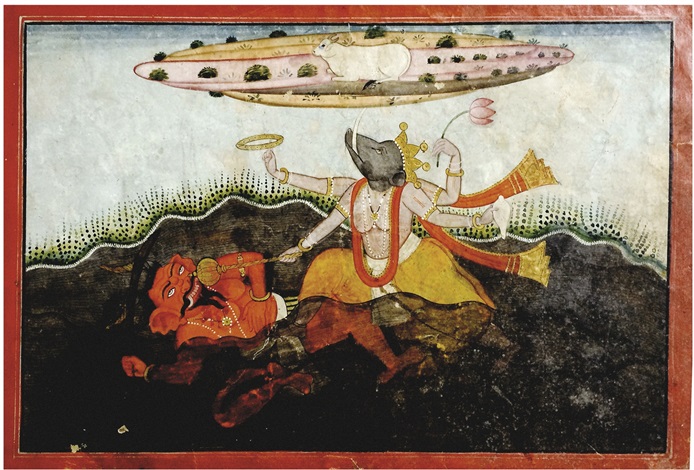
Sloka - 14: Meaning
87. Dandakasuravidhwamsi: When Lord Venkatesa took the form of a wild boar, He went after the demon Hiranyaksha who took a safe shelter in the Dandaka forest. In that pursuit, Lord Venkatesa encountered a huge battalion of demons and vanquished all of them without a trace. Further, many ages later, Lord Venkatesa as Sri Rama, killed an army of fourteen thousand demons in the battalion of Khara in the Dandaka forest.
88. Vakradamshtra: As a wild boar, Lord Venkatesa possessed sharp teeth or tusks. These teeth are slightly bent to facilitate the lifting of heavy objects and thus enable Him to rescue the submerged Earth from the grips of the demon Hiranyaksha. Poigai Alwar, who has a deep penchant for Lord Venkatesa, is awestruck by the magnitude of his teeth and exclaims “…Varaagaththu eyittru alavu podhaavaaru…” in Mudal Tiruvandaadhi [#84].
89. Kshamadhara: The word ‘Kshama’ indicates the Earth. It means forbearance and when alluding to the Earth this name connotes the immense patience of the Mother Earth, Bhudevi, exhibits towards Her inhabitants. Kshamadhara indicates Lord Venkatesa as the wild boar who held, rescued, and supported the Earth from the cosmic waters.
90. Gandharvasaapaharana: This name connects to an incident where a Gandharva by the name of Sundara, the son of a great Gandharva king Veerabahu, was cursed by the sage Vasishta. The sage accidentally spotted Sundara nude, while he was playing in Kaveri, and taken aback at such a sight, the sage immediately cursed him to attain the form of a ‘rakshasa'. As per Dharma Shastra, one should never bathe without wearing clothes. Lord Venkatesa killed this demon when he attempted to attack another sage in Venkatadri Hills. Thus the Gandharva regained his original form due to Lord
91. Punyagandha: Lord Venkatesa, as a form of stone exhibits divine fragrance. This divine fragrance is so unique and so special for ‘archa murthi vigraha.’ The Chandhogya Upanishad [#3.14.4] extols as “…sarva gandha: sarva rasa:”. He is the seat of all grand fragrances and grand tastes that draws the devotees towards Him to bestow them with ‘punya.’
92. Vichakshana: This name refers to a wise, skilled, and able man in general. Lord Venkatesa indicates that He is the source of all wisdom and skills and He bestows them to devotees who surrender to Him. Venkatesa.
Sloka - 15
Karalavaktra: Somaarkanetra: Shadgunavaibhava: |
Swetaghonee Ghurnithabhru: Ghurghuradhwanivibhrama: ||
Sloka - 15: Meaning
93. Karalavaktra: The word ‘Karala’ indicates a form that is the most horrific and frightening at first sight. Lord Venkatesa as Varaha exhibited such a fear-instilling face and especially His mouth with two terrible tusks that was so scary to the likes of Hiranyaaksha and simultaneously most benign to the Bhudevi, the Earth, who was waiting for protection.
94. Somaarkanetra: Lord Venkatesa is known to have Lord Chandra as the left eye and Lord Surya as the right eye. The Purushasukta says ‘Chakshussuryo Ajaayata'. Lord Surya took His form from the eyes of Lord Venkatesa.
95. Shadgunavaibhava: The presence of six qualities repository of Eternal Wisdom [Gnyaana], Strength [Bala], Prosperity [Aiswarya], Potence [Veerya], Endurance [Sahana], and Radiance [Tejas] define the word ‘Bhagavan.’ The Bhaktisaara attributes these six qualities to Sriman Narayana as “… Eru seer irandu moonrum ezhum Aaarum ettumaai …” in his Tiruchandaviruttam [#2].
96. Swetaghonee: Lord Venkatesa in Varaaha ‘avatar’, was an immaculate white-colored boar. Pure spotless white is an indication of a seat of knowledge of the highest order. Lord Venkatesa bestows the devotees with great knowledge.
97. Ghurnithabhru: Lord Venkatesa, as Varaaha reigned over Hiranyaksha and in the ensuing battle His anger for the demon increased and naturally reflected in His facial expressions. Especially, this name indicates a special mention of His otherwise mesmerizing eyebrows assuming a twist as a result of His immense anger He developed towards the immoral demon.
98. Ghurghuradhwanivibhrama: Lord Venkatesa is called by the typical snorts or grunts which are the characteristic of a boar in His Varaaha Avatar. This is one of the various ploys employed in His ‘Varaaha avatar’ to dominate and eventually kill the demon for establishing ‘Sanatana Dharma.’
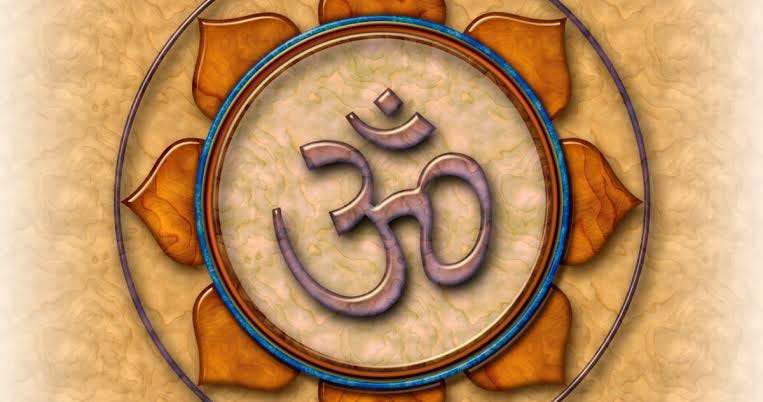
Sloka - 16
Draagheeyaan Neelakesi cha Jagradambujalochana: |
Ghrunaavan Ghrunisammoho Mahakaalagnidheedhithi: ||
Sloka - 16: Meaning
99. Draagheeyaan: Lord Venkatesa as Varaaha was colossal in form. Vishnu Sahasranama [#542] says “Mahavaraaha”. The mighty Meru mountain is described to be locked adjacent to the tiny metal balls in the anklet worn on Varaaha’s leg.
100. Neelakesi: Lord Venkatesa’s refulgent, dense, and pitch black hair is described here. Nammalvar, in Tiruvaymozhi [#7.7.9], while being awestruck by the richness in the blackness of His hair exclaims “Kolkinra kol irulai sugirnditta kozhun surulin…”
101. Jagradambujalochana: A Lotus flower in a fully blossomed state is such a pleasant sight for anyone. Lord Venkatesa’s eyes resemble such a beautiful blooming lotus flower. Sri Prativadibhayankara Annan, in his Sri Venkatesa Mangalam [#10] states that the mercy overflowing from the lotus-eyes of Lord Venkatesa inundates the entire universe “Dayaamruta taranginyaas tarangairiva sheetala:”
102. Ghrunaavan: Lord Venkatesa is mercy personified. Varaaha avatar is known by this name. This fact can be further corroborated by the Varaaha Charama Sloka. Varaaha Swamy in His profound conversation with Bhudevi, mentions that He will remember His devotee and bestow the devotee in his last days with the ultimate destination, who, while being in an overall healthy condition during his lifetime remembers the ‘Viswaroopa’ of Varaaha Swamy.
103. Ghrunisammoha: Lord Venkatesa as Narasimha exhibited the most fierce nature towards Hiranyakasipu while mellowed down to a great extent in dealing with His devotee Prahlada. Such a form is the most fascinating form for the devotees
104. Mahakaalagnidheedhithi: Lord Venkatesa as Narasimha displayed an effulgent equivalent to that of the ultimate cosmic closure, Maha Pralaya. He is Himself the most frightening Kaalagni.
Sloka - 17
Jwaalakaraalavadano Maholkakulaveekshana: |
Sataanirbhinnameghaugho: Dhamshtrarugvyaaptadhikthata: ||
Sloka - 17: Meaning
105. Jwaalakaraalavadana: Lord Venkatesa as Narasimha was full of intense rage, not seen by anyone till then. The rage manifested on His face. Tirumangai Alwar says “Mulaittha Seettram Vinsudappoi…” in Periya Tirumozhi [#1.7.7].
106. Maholkakulaveekshana: The eyes of Lord Venkatesa in His Narasimha Avatar are described in this name. The eyes, which otherwise shower nectarine mercy on His devotees, were erupting like an explosive volcano spewing out the hottest emissions. Vadikesari Jeeyar exclaims in his Narasimhaashtakam [#7] “Indu Ravi Paavaka Vilochana...”
107. Sataanirbhinnameghaugha: Lord Venkatesa as Narasimha was gigantic. His form was so huge that the clusters of His mane around the neck appeared like the clouds in the sky disturbed by torrential winds. Sri Vedanta Desika says “Sataapatala bheeshane sarabha saatta haasotbhate” in his Kaamasikashtakam [#7]
108. Dhamshtrarugvyaaptadhikthata: The glorious glow of Lord Narasimha’s teeth is detailed by this name. The teeth are described to be extremely bright and lit up His ferocious face and there by the overall sight are frighteningly brilliant. The glow of the teeth is said to have spread in all directions around till the end of the universe.
Sloka - 18
Ucchwasakrushtabhutesa Niswasatyaktaviswasrut |
Antharbhramajjagadgarbho: Anantho Brahmakapalahrut ||
Sloka - 18: Meaning
109. Ucchwaasaakrushtabhutesa: In this name Bhutesa refers to Rudra. In the times of pralaya, Venkatesa as Narasimha, through His inhalation of breath, attracted Rudra towards him in an attempt to protect him.
110. Niswasatyaktaviswasrut: Venkatesa, in an exhalation of breath, created Lord Brahma. The purpose of Brahma’s creation was to continue the process of creation of the rest of the universe as directed by Venkatesa.
111. Antharbhramajjagadgarbha: Venkatesa is the Lord who holds the entire, ever-moving universe inside His stomach in an attempt to safeguard it. Tirumangai alwar says “Manjaadu varai ezhum… enjamal vayittradakki…” in Periya Tirumozhi [#2.10.1]
112. Anantha: This name signifies Venkatesa’s trait of being endless. Endless, not only intends about the lifespan but also to all the attributes that supplement a life. Venkatesa’s auspicious qualities, His opulence, His power, His avatars, etc., are all endless. Nammalvar says “…Tholgal aayiratthay mudigal aayiratthay thunai malar kangal aayiratthay…” in Tiruvaymozhi [#8.1.10].
Parasara Bhatta attributes the limitlessness by space, time, or object in his commentary to Vishnu Sahasranama [#665]
113. Brahmakapalahrut: Venkatesa was the one who came to rescue Rudra when the latter was roaming around with a skull attached to his hand due to his blasphemous act of plucking the 5th head of Brahma. This act entailed Rudra roaming around to seek liberation from that sin and eventually Sriman Narayana helped Rudra by pouring the nectarine water from His bosom to fill the attached skull. Tirumangai Alwar recounts this in Periya Tirumozhi [#1.5.8]
Sloka - 19
Ugro Veero Mahavishnur Jwalana: Sarvathomukha: |
Nrusimho Bheeshano Bhadro Mrutyumruthyu: Sanaatana: ||
Sloka - 19: Meaning
114. Ugra: The name signifies the extreme fury that manifests in Venkatesa towards the incorrigible sinners. This name is dealt with by Parasara Bhatta in his commentary for Vishnu Sahasranama [#422] to signify Kalki avatar. Poushkara Samhita also alludes to the same in the context of the depletion of Dharma.
115. Veera: Venkatesa is the Veera who instills fear and terror in the hearts of enemies of followers of Dharma. Vedanta Desika addresses Rama as “Mahaveera!!” in his Raghuveeragadya. Maareecha recounts as to what happened to Ravana with such fear and exclaims that he sees Rama in every tree around him, which signifies a form of devotion, driven purely by fear [Bheeta Bhakti]. Annamayya says “Jayajaya Nrusimha Sarvesabhayahara Veera.” Vishnu Sahasranama also employs this name twice [#402, 664].
116. Mahavishnu: The name Vishnu indicates the pervasiveness of Venkatesa. In Mahabharata, Udyoga Parva [#69.13], the name Vishnu is attributed to His act of spreading across and measuring the three worlds with His feet. This name appears 3 times in Vishnu Sahasranama [#2, 259, 663].
117. Jwalana: Venkatesa is the radiating entity that emits incinerating fire that destroys the enemies of Dharma. Annamayya exclaims as “Palanetranala prabala vidyullata…”. When devotees approach Him, this radiance will burn their sins without a trace. 118. Sarvathomukha: Venkatesa’s trait of being a witness to everything and everywhere in any direction is explained by this name. This name alludes to the pervasiveness of Venkatesa. Nammalvar says “Karandhengum parandhulan” in Tiruvaymozhi [1.1.10].
119. Nrisimha: Venkatesa is Nrisimha who simultaneously rescued Prahlada while also ensuring that Brahma’s boons are not violated. Venkatesa, as Nrisimha ensured showered immeasurable grace on Prahlada on one hand while He was most frighteningly ferocious towards Hiranyakasipu. Tirumangai Alwar says “…Thinnthiral Ariyaayavan, Thiruvengadam…” in Periya Tirumozhi [#1.8.6].
120. Bheeshana: As Bheeshana, Venkatesa orchestrates the world in such a way that the unrighteous people who frequently transgress the path of rectitude will constantly feel the fear of the consequences of their unrighteous acts in their lives. Vishnu Sahasranama [#837] says “Bhayakrut”
121. Bhadra: The word “Bhadra” signifies auspiciousness. Venkatesa bestows His devotees with all the auspiciousness by eradicating the obstacles due to their past karma. Nammalvar says “…onrume thozha nam vinai oyume” in Tiruvaymozhi [#3.3.8]. Annamayya says “...niratam nityam nikhila subhakaram... parama mangalam bhavatitam...” 122. Mrutyumruthyu: Venkatesa is considered to be the personification of End to Death. His grace effectively thwarts the untimely death of His devotees.
Yamadharmaraja fears the Paramatma, Venkatesa. “…Mrutyurdhaavati panchama iti” says Aanandavalli in Taittiriyopanishad which indicates Death fears the Paramatma.
123. Sanaatana: This name signifies the most ancient nature of Venkatesa. Brahma Purana says that King Sanka built the temple for Venkatesa on Tirumala and established the idol form exactly as revealed. This is mentioned by Tirumalai Ananthalwan in his work, Sri Venkatachala Ithihasa Mala. Vishnu Sahasranama [#898] says “Sanaatana-tama:” which indicates even a higher degree of ancient nature.
Sloka - 20
Sabhasthambhodbhavo Bheema: Siromaali Maheswara: |
Dwaadasaadithyachudaala: Kalpadhoomasataachavi: ||
Sloka - 20: Meaning
124. Sabhasthambhodbhava: This name signifies the avatar of Narasimha from a pillar. In Srimannarayaneeyam [25.1], Bhattadri says “Sthambhe ghattayatho Hiranyakasipo….” When the demon questions the presence of Hari, the great devotee Prahlada informs the demon that Hari is present everywhere. Prativadi Bhayankaram Anna says “sarvaantaraatmane srimad venkatesaya namha”.
125. Bheema: Venkatesa is attributed with the quality of being frightful to those who are averse to the great grace He showers. All the elements fear Him. Aanandavalli in Taittiriyopanishad says “Bheeshamaad vaatah pavate, Bheeshodheti Surya:…” During Narasimha avatar, other Gods were perplexed in fear after witnessing a most improbable combination of a lion's face with eyes spewing fire on a human torso. Tirumangai Alwar explains this in Periya tirumozhi [#1.7.6] as “Erintha paingan ilangu pezhvaay….” This name appears twice in Vishnu Sahasranama [#357, 948].
126. Siromaali: This name of Venkatesa alludes to the infinite heads. Purushasukta says “Sahasraseersha: purusha:…” The word sahasra in Sanskrit indicates a finite number 1000 as well as being infinite as well. Periyalwar says “aayiram thol parappi mudi aayiraminnilaga…” in Periyalwar Tirumozhi [#4.3.10].
127. Maheswara: Venkatesa is the Lord of wealth. By wealth, not only materialistic wealth but every kind of wealth like knowledge [gnaana], devotion [bhakti], and also the wealth of sense of detachment from all materialistic wealth [vairagya]. Venkatesa is seen as the bestower of anything to anyone who beseeches Him with devotion. The word “Maha” indicates a higher magnitude. Nammalvar says in Tiruvaymozhi [#8.1.5] “…manisarkku devar pola devarkkum deva o!...”
128. Dwaadasaadithyachudaala: The 12 Aaditya devas are resting as ornaments atop the crown of Venkatesa. Srimannarayana is known as “Savithru mandala madhyavarthee,” as the Lord who resides on the horizon of the Sun [Ravi Mandala].
129. Kalpadhoomasataachavi: During Narasimha avatar, this name signifies the beauty of His manes or hair locks in the battle with the demon. Narasimha realizes that He has killed the demon and shakes off His head in an act of ecstasy resulting in the manes being similar to the smog during the pralaya. Vedanta Desika explains this in Kaamasikaashtakam [#7] as “Sataapatala bheeshane sarabha saatta…”
More details will be added, we are updating this page monthly. Keep checking this page for Slokas
